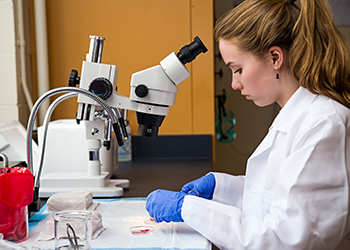Recent Grants in Biomedical Sciences
 Dr. Hearing received a $2.2 million RO1 from the NIH to study opioid addiction and its neurological underpinnings. Despite the known risks of dependence and cognitive impairments associated with opioid-based pain management, the neural and psychological basis of opioid addiction remains understudied. Addiction is characterized by impaired decision-making, perseverance, and a strong motivation to obtain drugs, but these behaviors vary among individuals.
Dr. Hearing received a $2.2 million RO1 from the NIH to study opioid addiction and its neurological underpinnings. Despite the known risks of dependence and cognitive impairments associated with opioid-based pain management, the neural and psychological basis of opioid addiction remains understudied. Addiction is characterized by impaired decision-making, perseverance, and a strong motivation to obtain drugs, but these behaviors vary among individuals.
The grant examines the role of prefrontal circuits in the transition to addiction, with hypoactivity in these circuits being a primary mechanism. The study uses a potent opioid, remifentanil, to investigate how it promotes hypoactivity in the prelimbic cortex (PrL), leading to cognitive inflexibility, and how this effect differs between males and females. Pilot data suggest that this inflexibility is associated with increased perseverative drug-seeking behavior, especially in females.
One of the grant’s primary objectives is to investigate synaptic plasticity using in vivo calcium imaging and chemogenetics to understand the transition from drug-induced synaptic changes to behavioral outcomes. The aims include examining exposure-dependent changes in PrL-Core circuits, assessing the contribution of circuit flexibility to drug-seeking behavior, and identifying synaptic modifications at D1- and D2- MSN synapses within the PrL-Core circuits. The ultimate goal is to gain insight into the development of addiction and its effects on function and behavior, with potential implications for more tailored treatments based on sex and addiction stage.
 Dr. Blackmore was awarded a $2.2 million RO1 by the NIH to study axon regeneration in the central nervous system (CNS) in adults using a multi-faceted research approach. Typically, axons in the CNS fail to regenerate after injury, resulting in permanent disabilities due to a hostile growth environment and the loss of intrinsic regenerative capacity in aging CNS neurons.
Dr. Blackmore was awarded a $2.2 million RO1 by the NIH to study axon regeneration in the central nervous system (CNS) in adults using a multi-faceted research approach. Typically, axons in the CNS fail to regenerate after injury, resulting in permanent disabilities due to a hostile growth environment and the loss of intrinsic regenerative capacity in aging CNS neurons.
The research focuses on transcription factors (TFs) as potential therapeutic targets to enhance regenerative abilities in injured neurons. Specifically, KLF6 is a pro-regenerative TF that, when reintroduced in adult neurons, can improve axon growth after spinal injury.
The research plan involves three key strategies:
- Identifying Synergistic TFs: Using a bioinformatics pipeline, the researchers identify TFs that functionally interact with KLF6 to enhance axon growth. They plan to test three selected factors, EOMES, NR5A2, and RARB, in animal models of spinal cord injury.
- Stem Cell Transplants: The study includes transplanting growth-permissive stem cells into spinal injury sites to counteract the inhibitory environment in the spinal cord, allowing the pro-regenerative effects of TF treatments to manifest.
- Gene Therapy: The researchers will use an advanced gene therapy vector for efficient gene delivery to injured neurons in various regions of the CNS, potentially maximizing functional recovery.
Tissue clearing and 3D microscopy techniques will also be employed to gain new insights into the regenerative process. The overall goal is to develop novel and effective treatments for individuals suffering from CNS injuries, offering hope for those facing permanent disabilities resulting from axon damage in the CNS.
 Disrupted daily rhythms caused by abnormal light exposure and genetic variations in circadian genes hold significant health implications. Aberrant light exposure, often due to excessive artificial lighting at night, has a widespread impact, affecting up to 80% of the American population. Genetic variations in circadian genes can lead to sleep disturbances and heightened societal and personal burdens.
Disrupted daily rhythms caused by abnormal light exposure and genetic variations in circadian genes hold significant health implications. Aberrant light exposure, often due to excessive artificial lighting at night, has a widespread impact, affecting up to 80% of the American population. Genetic variations in circadian genes can lead to sleep disturbances and heightened societal and personal burdens.
Dr. Evans was awarded over $800,000 in R21 funding from the NIH to address a gap in understanding in circadian biology – how changes in the molecular clock translate into health outcomes and pathologies. To address this issue, the study proposes using Syrian hamsters, a rodent species that possesses a functional melatonin system and exhibits a diverse range of circadian and photoperiodic responses to light. Dr. Evans has developed the first circadian reporter in this hamster model and plans to investigate circadian timekeeping at both central and systemic levels.
Additionally, the research intends to leverage well-characterized mutations in hamsters that affect circadian clock function, photoentrainment, and physiological processes. The ultimate goal is to establish the groundwork for using this animal model to gain a more comprehensive understanding of circadian and photoperiodic processes that have implications for human health.

 Dr. Hearing received a $2.2 million RO1 from the NIH to study opioid addiction and its neurological underpinnings. Despite the known risks of dependence and cognitive impairments associated with opioid-based pain management, the neural and psychological basis of opioid addiction remains understudied. Addiction is characterized by impaired decision-making, perseverance, and a strong motivation to obtain drugs, but these behaviors vary among individuals.
Dr. Hearing received a $2.2 million RO1 from the NIH to study opioid addiction and its neurological underpinnings. Despite the known risks of dependence and cognitive impairments associated with opioid-based pain management, the neural and psychological basis of opioid addiction remains understudied. Addiction is characterized by impaired decision-making, perseverance, and a strong motivation to obtain drugs, but these behaviors vary among individuals. Dr. Blackmore was awarded a $2.2 million RO1 by the NIH to study axon regeneration in the central nervous system (CNS) in adults using a multi-faceted research approach. Typically, axons in the CNS fail to regenerate after injury, resulting in permanent disabilities due to a hostile growth environment and the loss of intrinsic regenerative capacity in aging CNS neurons.
Dr. Blackmore was awarded a $2.2 million RO1 by the NIH to study axon regeneration in the central nervous system (CNS) in adults using a multi-faceted research approach. Typically, axons in the CNS fail to regenerate after injury, resulting in permanent disabilities due to a hostile growth environment and the loss of intrinsic regenerative capacity in aging CNS neurons. Disrupted daily rhythms caused by abnormal light exposure and genetic variations in circadian genes hold significant health implications. Aberrant light exposure, often due to excessive artificial lighting at night, has a widespread impact, affecting up to 80% of the American population. Genetic variations in circadian genes can lead to sleep disturbances and heightened societal and personal burdens.
Disrupted daily rhythms caused by abnormal light exposure and genetic variations in circadian genes hold significant health implications. Aberrant light exposure, often due to excessive artificial lighting at night, has a widespread impact, affecting up to 80% of the American population. Genetic variations in circadian genes can lead to sleep disturbances and heightened societal and personal burdens.
